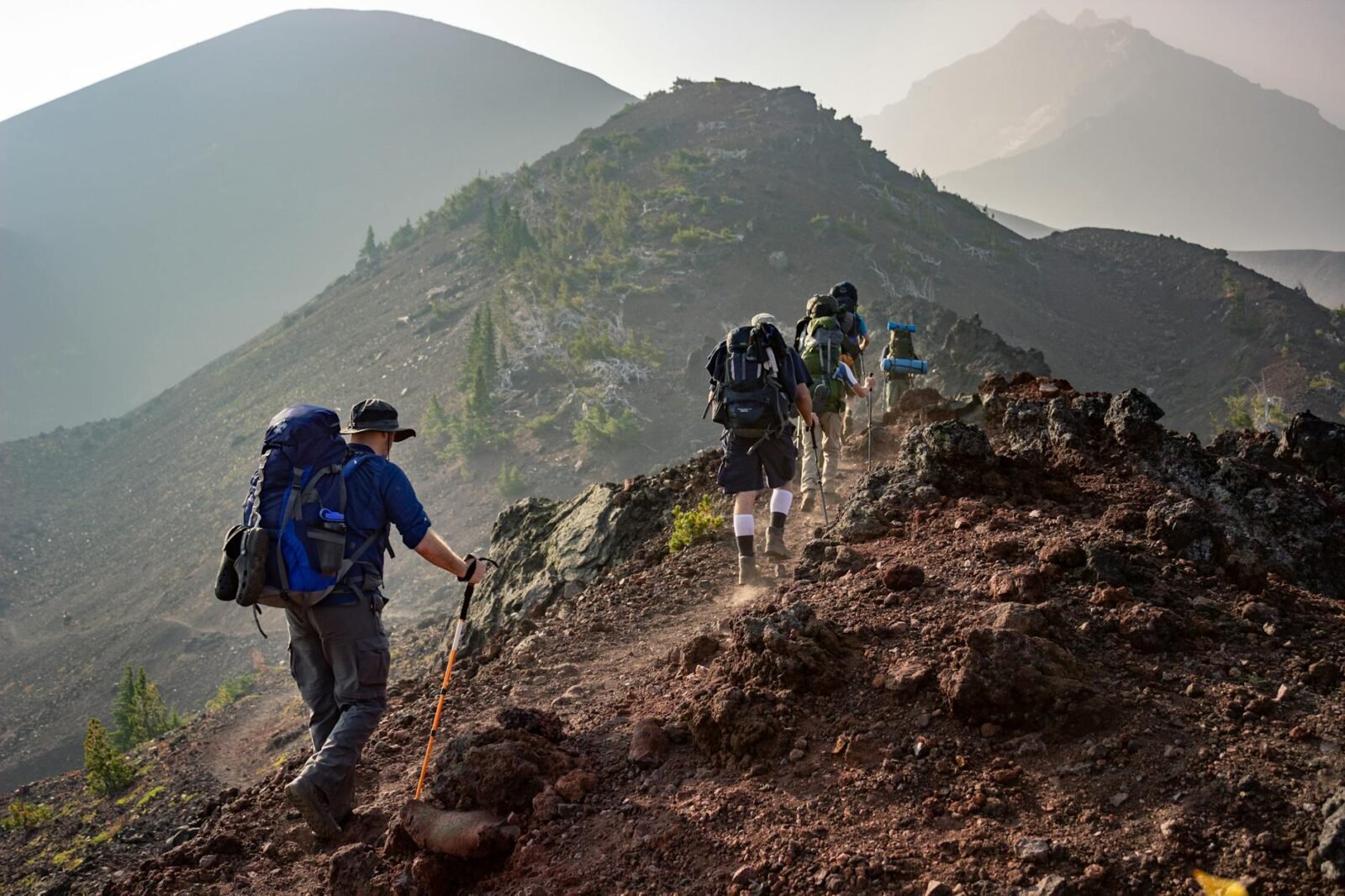Last Updated on July 16, 2024 by Daniele Lima
Everything You Need to Know Before Going on a Hike
Hiking has become an increasingly popular pastime among those looking for a way to connect with nature, stay healthy, and enjoy outdoor adventures. From beginners looking to take their first steps on local trails to experienced hikers trying out more demanding terrain, the world of hiking offers options for all experience and fitness levels.
This comprehensive guide, Hiking Guides: From Beginner to Advanced – Everything You Need to Know Before You Start Wondering, is designed to provide all the essential information to ensure a safe and rewarding experience. We’ll learn about everything from choosing the right equipment, and physical and mental preparation, to special tips for different terrains and weather conditions. Get ready to embark on a journey that goes beyond walking, offering self-discovery, overcoming limits, and an intimate connection with the natural beauty that surrounds you.
Table of Contents
Choosing the perfect route
The first step to a successful hike is choosing a route that suits your experience and fitness. Short, well-signposted trails are ideal for beginners. These trails are generally flat and provide a good introduction to the activity without requiring special physical preparation.
As you gain experience and confidence, you can begin to explore more difficult paths. Intermediate trails tend to have more varied terrain, including climbs and longer distances. For advanced hikers, long trails with rugged terrain, such as mountains and dense forests, are ideal for testing limits and skills acquired over time.
What to wear hiking
Essential hiking equipment

Regardless of the difficulty level of the route, good equipment is essential. Basic hiking equipment includes:
Suitable footwear: Boots or shoes with good support and non-slip soles are essential to avoid sprains and falls.
Comfortable Backpack: Carrying water, food and other necessities requires an ergonomic and durable backpack.
Suitable clothing: opt for lightweight, breathable clothing for trails in hot weather and an extra layer for cold weather. Waterproof clothing is essential in the face of unexpected rain.
Trekking poles: poles can help increase stability and reduce impact on joints, especially on rough terrain.
First aid: Contains items such as bandages, antiseptics, pain relievers, and any necessary medications.
Map and compass: Even with GPS, using a map and compass in areas without signals is a valuable skill.
Flashlights and extra batteries are: essential on walks and can last until dusk or in emergency situations.
Physical and mental preparation

The trails require physical and mental preparation. For beginners, it’s important to start with short walks and gradually increase the distance and level of difficulty. Stretching and strengthening exercises can prevent injuries and improve performance.
Mental preparation is equally important. Recognizing challenges and maintaining a positive attitude are key factors in overcoming difficulties along the way. Practicing breathing and meditation techniques will help you stay calm and focused during a hike.
Tips for safe walks
Safety must come first on all hikes. Some important tips are:
Discover the route: Know the distance, type of terrain, and weather conditions of the route. Check the weather forecast before heading out.
Tell someone about your plans: Tell your friends or family about your route and estimated return time.
Hydrate and eat well: Bring plenty of water and energy-dense foods, such as whole grains and dried fruit.
Respect nature: follow Leave No Trace principles to minimize environmental impact. Collect rubbish and respect the local flora and fauna.
Be prepared for emergencies: have an emergency action plan, such as knowing the telephone numbers of local emergency services and understanding emergency signs.
Advanced Hiking: Challenges and Overcoming
For advanced hikers, the trails offer more intense challenges and require even more in-depth preparation. In addition to the basic equipment, additional equipment such as snow blankets, climbing ropes, and more advanced navigation skills are required.
Trekking in high altitudes or remote areas tests endurance and survival skills. It is important to be physically and mentally fit to face tiredness, loneliness, and any adverse conditions.
Health benefits of walking

Walking has many benefits for physical and mental health. Among the most important, the following stand out in particular:
Improves cardiovascular health: Regular walking strengthens the heart, lowers blood pressure, and improves circulation.
Muscle strengthening: Walking on different terrains helps strengthen the muscles in your legs, glutes, abdominals, and back.
Weight control: Walking is a great way to burn calories to help you lose weight and keep it off.
Stress reduction: Contact with nature and movement promotes the release of endorphins, hormones that combat stress and anxiety.
Increased mental toughness: Facing challenges and overcoming obstacles during a walk can increase resistance and the ability to deal with adverse situations.
Planning long walks
Planning hikes that last more than one day, such as long-distance trails or expeditions, is very important. Some important considerations are:
Choose a route: Research the route in detail, including stops, campsites, and drinking water sources.
Reservations and replacement: Calculate the required amount of food and water. Bring non-perishable, high-energy foods such as nuts, protein bars, and freeze-dried foods.
Camping equipment: Bring items such as a tent, sleeping bag, thermal insulation, portable stove, and light batteries.
Physical preparation: Long walks require good physical preparation. Practice in advance by taking smaller trips with a loaded backpack to simulate the conditions you will encounter.
Time management: Plan your trip so that you have enough time to set up camp before dark and get enough rest.
Trail Navigation
Knowing how to find your way around trails is an essential skill, especially in remote areas or areas with little signage. In addition to maps and compasses, other useful tools include:
GPS and Navigation Apps: GPS devices and smartphone navigation apps can provide accurate coordinates and real-time trail information.
Knowledge of Brands and Signs: Familiarize yourself with specific trail markings and signs, which indicate the correct path, hazards, and points of interest.
Map Reading: Practice reading topographic maps, which show relief, rivers, trails, and other important geographic details.
Reference points: Identify natural landmarks, such as mountains, rivers, and rock formations, to help with orientation.
Conclusion: Well-being on the move
Walking is more than physical exercise; AND an opportunity to explore the world, connect with nature, and challenge your limits. He wants you it be a beginner or veteran in trails, planning and preparation are essential for a safe and pleasant. Remember to respect nature, equip yourself appropriately, and follow safe practices. With these tips and instructions, you will be ready for all adventures that the trails offer. Have a nice walk!
Hiking Guides – FAQ:
What is the golden rule of hiking?
The golden rule of hiking is to respect nature and follow Leave No Trace principles. This means minimizing your environmental impact by carrying out all trash, staying on designated trails, and not disturbing wildlife or plants. By adhering to these guidelines, hikers help preserve the natural beauty and integrity of the trails for future generations.
Additionally, respecting other hikers by yielding the trail when necessary and maintaining a polite demeanor contribute to a positive outdoor experience for everyone.
What does a hiking guide do?
A hiking guide leads groups on outdoor adventures, ensuring safety and providing an enriching experience. They are responsible for planning the route, navigating the trails, and managing group dynamics. Guides share their knowledge of the local flora, fauna, and geography, enhancing the hiking experience through education.
They also handle emergency situations, carry first aid kits, and ensure that all participants are prepared with the necessary gear and supplies. By doing so, hiking guides help create a safe, informative, and enjoyable hiking experience for everyone involved.
How much do backpacking guides make?
Backpacking guides’ earnings vary widely based on factors such as location, experience, and the type of trips they lead. On average, backpacking guides can earn between $100 to $300 per day. Some highly experienced guides working for reputable companies or leading specialized expeditions may earn even more.
Additionally, tips from satisfied clients can significantly boost a guide’s income. Freelance guides might have varying incomes depending on the number of clients and trips they secure.
What is the difference between hiking and trekking?
Hiking and trekking both involve walking in natural environments, but they differ in intensity and duration. Hiking typically refers to shorter walks on well-defined trails, often completed within a single day. It’s accessible to people of various fitness levels and usually requires minimal gear.
Trekking, on the other hand, involves longer journeys, often lasting several days, and covers more challenging and remote terrains. Trekkers usually camp or stay in lodges along the way and carry more extensive equipment, including food, shelter, and additional clothing. Thus, while hiking is generally more accessible and less demanding, trekking offers a more immersive and strenuous outdoor experience.











Leave a Reply